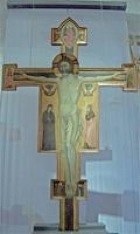

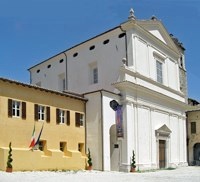
Bishop Bartolomeo Accoramboni founded a hospice and nunnery here in 1254. According to tradition, he saw a bright star shining on a well on this site and when he investigated the following day he discovered the bodies of abandoned babies inside it. He therefore built the hospice in order to care for abandoned children.
In the document by which he established the hospice, Bishop Accoramboni criticised the canons of San Gregorio Maggiore for their dereliction in allowing their old hospice (which stood nearby) to fall into dilapidation. He prohibited them from interfering in the new foundation, although in fact close links developed between the canons and the new hospice.
Bishop Accoramboni acquired this site from the canons of San Gregorio Maggiore in February 1254 and laid the foundation stone of the new hospice in March. Work was completed in a few months. He then established an adjacent nunnery under the Augustinian rule, and introduced a dispensation for the nuns to allow them to care for the inhabitants of the hospice (pilgrims, orphans and the sick). He moved the few remaining nuns from San Tommaso to the new nunnery in 1259. The nuns were given control of the hospice at San Giacomo di Spoleto in 1291.
The nunnery became one of the most important and one of the richest in Umbria. A number of nuns moved here as their respective nunneries closed in the 14th and 15th centuries:
-
✴those from two nunneries on Colle Ciciano:
-
•Santa Margherita “iuxta Spoletium”, in 1410; and
-
•San Concordio (now San Salvatore) in 1424; and
-
✴those from two nunneries on Monteluco:
-
•Santa Maria Maddalena di Monteluco, in 1443; and
-
•Sant’ Elisabetta, in 1447.
In 1392, the nuns took over the hospice at San Matteo. The Blessed Marina Petrucciani and a few other nuns moved from Santa Maria della Stella to this new site in 1473 in order to form a reformed community there. At this point, the activities of the hospice at San Matteo transferred to Santa Maria della Stella.
The nuns of Santa Maria della Stella decided to join the Lateran Congregation of the Augustinian Canonesses in 1502. A number of the nuns who did not want to make this change moved to Sant' Angelo in 1519.
From this point, the hospice began to decline and the nuns became the subject of widespread criticism. The authorities attempted to separate the hospice from the nunnery in 1639 but they were unable to satisfy the nuns on the arrangements for the division of the associated income and property. The no longer cared for the sick: nor did they provide accommodation for pilgrims. In effect, their charitable work was confined to the care of orphans.
In 1726 the nuns transferred the remaining orphans in their care to Santo Spirito, Rome. A few of the orphans died during this journey, and the resulting scandal prompted Pope Clement XII into action. He sent Monsignor Martino Innico Caracciolo to Spoleto in 1738 to reform the provision of care for the sick and for orphans in the city. He formally removed from the nuns any obligation to care for the orphans, in return for an annual payment, and transferred their residual charitable obligations to San Carlo Borromeo.
The nunnery was suppressed in 1798, at which point the complex was adapted to serve as a barracks (Caserma Minervio) and military hospital. The canonesses managed to keep their community in existence at the Monastero della Passione in Via Vaita de Domo (see Walk II). They moved to San Ponziano in 1903.
The church now serves as an auditorium of the Teatro Lirico Sperimentale di Spoleto.
SS Stefano e Tommaso (1786-93)

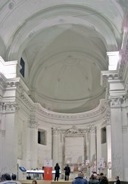
Originally, there were two churches in the complex:
-
✴the nuns' church of Santa Maria della Stella (1254); and
-
✴the hospital chapel of San Stefano (1259).
These were replaced by the current church, which is formally known as SS Stefano e Tommaso, although it is usually referred to as Santa Maria della Stella.
Nunnery and Hospice
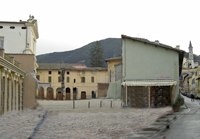
The ancient hospice stood to the left of the church.
The nunnery extended along Via dell' Anfiteatro (to the right in the illustration) as far as the ruins of the Roman amphitheatre.
[The passage to the right of the church leads to the cloister ?]
Art from Santa Maria della Stella
Painted Crucifixes
Two painted Crucifixes from the church are now in Room 9 of the Museo del Ducato di Spoleto:
-
✴one from the 13th century; and

Triptych (early 14th century)
This important triptych is attributed to the Maestro di Cesi. The central panel contains a representation of the Assumption of the Virgin while the side panels contain scenes that recount the events leading up to her death.
The triptych was documented in Santa Maria della Stella in 1861, some 60 years after the nuns had left for the Monastero della Passione and their old nunnery had been converted into a barracks. (It is possible that their new nunnery was known in 1861 by the title of their old one). It was documented again in the Monastero della Passione in 1872 but was subsequently sold illegally. Giuseppe Sordini tried to locate it in the period 1892-4 but failed. The scholar Millard Meiss found the triptych in the collection of the Rothschild family at Villa Ephrussi de Rothschild, Saint-Jean-Cap-Ferrat and attributed it to the Maestro di Cesi. The scholar Marilyn Aronberg Lavin recently identified it as the lost work from Santa Maria della Stella. It is now in the Musee Marmottan, Paris. (An illustration of the triptych is available on the website of the Bridgeman Art Library).
Madonna della Stella (1502)
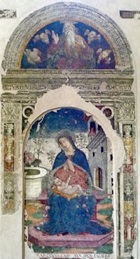
The main scene depicts the praying Madonna enthroned, with the baby Jesus on her lap. She sits under a starry sky, with a well to her right. This is a reference to the circumstances in which Bishop Bartolomeo Accoramboni founded the hospice for abandoned babies here in 1254 (see above).
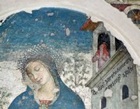
This scene is surrounded by a fictive frame, with God the Father in the lunette above.
Tabernacle (1523)
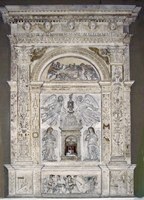
The relief at the centre of the predella depicts the martyrdom of St Stephen. Those to the left and right of it outline the foundation story of the hospice (see above):
-
✴a star appears over a well outside San Gregorio, which leads to the discovery of the bodies of abandoned babies that have been thrown into it; and
-
✴this causes Bishop Bartolomeo Accoramboni to establish a hospice for abandoned babies on the site (in 1254).
Incredulity of St Thomas (1758)
This panel, which is signed by by Etienne Parrocel, il Romano and dated by inscription, came from SS Stefano e Tommaso. [It was in the Pinacoteca - is it in Palazzo Comunale?]
